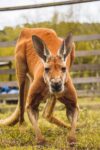
Consultant: Zoo does not ‘advertise’ animals’ deaths
Narissa Fraser

ZOO consultant John Seyjagat says while the Emperor Valley Zoo “does not advertise the deaths of animals,” he can assure the public that Jack the red kangaroo got a proper burial and sendoff after he died in May.
Jack was removed from his enclosure in March after photos of him looking emaciated went viral on social media.
The Ministry of Agriculture investigated and concluded the animal was “in fair health.”
He had been taken from the now-defunct Safari Eco Park in Chaguaramas in January 2023.
The zoo had said he came in with “physical issues,” which former officials of the park denied.
Newsday tried to find out how Jack was doing post-investigation for several months, as he never returned to his enclosure.
It was only on Sunday, after Newsday published a story on the zoo’s not responding to calls, messages and e-mails about Jack, that an answer was provided.
In a statement, Seyjagat said Jack died on May 3.
“(The cause) of death as diagnosed (was): cardiomyopathy – diffuse; pulmonary congestion – acute mild to moderate and diffuse with focal granuloma; enteritis – segmental, acute mild; hepatic congestion – diffuse and moderate with capsular fibrosis, moderate with capsular fibrosis, diffuse mild and chronic.”
Cardiomyopathy is a disease of the heart.
“The cardiomyopathy is likely the main contributor to the death of this animal, leading to pulmonary and hepatic congestion with fibrosis,” the statement said.
Speaking to Newsday by phone on Monday, Seyjagat apologised for the lack of transparency.
Many people on social media are now asking why Jack’s death is only just being announced six months later.
Asked about this, Seyjagat said, “The zoo does not advertise when an animal dies.
“All public-relations matters have to go through the right channels and the Ministry (of Agriculture), etc.”
He said sometimes, depending on the popularity of the animal, the zoo may decide to publicise a death.
In 2014, the zoo publicly announced the death of Simba, an African lion. The same was done in 2017 for a zebra named Marty and an American crocodile named Crocky, and in 2019 for another red kangaroo, after Independence Day fireworks.
Seyjagat said when animals at the zoo die, a necropsy (autopsy) and pathology report are done.
“Or we send out tissues and samples for histology (microscopic study of tissues).”
Some social media users also questioned whether animals that die at the zoo are fed to any of the larger animals. Seyjagat said no, and that the zoo would never do this.
“They are either buried or incinerated (burned).
“(Jack’s) carcass was buried. We won’t say where, but he was taken care of in the proper manner and it was done with dignity and respect.”
Initially, in March, the zoo had estimated Jack was 15-20 years old. But in its response on Sunday, it said he had lived a “full life,” but was actually 12-14 years old.
Seyjagat said they thought he was older but shipping information about Jack revealed his actual age.
On average, red kangaroos live up to eight years in the wild and up to 23 years in captivity.
A worker at the zoo recently told Newsday they were told Jack was sent to the San Diego Zoo in the US. That zoo denied this claim.
Asked about that, Seyjagat said he has no idea where such a claim came from and believes the worker was “just messing with” the media.
He added that a local vet – Dr Chantal Perryman – has experience working with kangaroos and the zoo has been working with her for years.
There is one red female kangaroo left at the zoo, who does not have a name or nickname. He said she is doing well.



